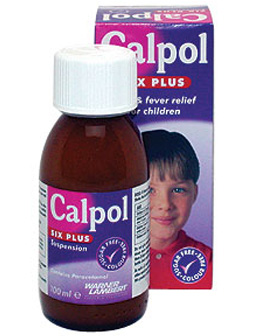To many parents Calpol has become synonymous with infant pain relief; rather like "Hoover" or "Tannoy" - the brand has become so big, you rarely hear the word paracetamol mentioned. But take a closer look and in reality the two are far from identical products.
In case you're thinking I'm having a bout of "Neurotic Mother Syndrome", it seems I'm not alone with my concerns. Research by The Food Commission has found that just 1 of 41 medications intended for children was additive free; many contained a cocktail of colourings, sweeteners and preservatives that can trigger allergic reactions such as rashes, eye irritation, stomach upsets and diarrhoea.
The researchers said that:
While some additives were needed to help children to take unpalatable medicines, the quantity of substances banned for use in food and drink for the under 3s raised concerns. They called for warnings on all medications that could trigger allergic reactions
Maltitol liquid, glycerol, polysorbate 80, sorbitol (E420) solution, methyl parahydroxybenzoate (E218), propyl parahydroxybenzoate (E216), ethyl parahydroxybenzoate (E214), dispersible cellulose, xanthan gum and purified water. carmoisine (E122)
To many, the list above doesn't mean much - so I will break it down further:
E122- the bit that makes it pink. A suspected carcinogen; banned in Austria, Japan, Norway, Sweden and the US. May cause allergic reactions. Hyperactive Children's Support Group identifies E122 as a likely cause of mysterious and sudden cases of ADHD-like hyper-activity.
E420 - A paraben preservative, can cause stomach upset. It is not allowed in foods intended specifically for babies or young children.
E218 - Suspected hormone disruptor. May cause allergic reactions (possibly delayed) Hyperactive Children's Support Group identifies E218 as a likely cause of mysterious and sudden cases of ADHD-like hyper-activity.
E214 - Suspected hormone disruptor, banned in France and Australia. May cause allergic reactions (possibly delayed)
E216 - Suspected hormone disruptor May cause allergic reactions (possibly delayed)
Hmmm suddenly that cute baby on the box, isn't looking quite so appealing! But as Calpol own a 70% share in the £70 million pound 'pain and fever' industry, I'm guessing they're not going to be rushing to make changes anytime soon - but why would they? Have you seen how many Calpol fan groups there are on Facebook? In contrast, although manufacturers claim reactions are rare, a poll on http://www.patientsville.com/medication/calpol_side_effects.htm found 70% of users reported a mild or moderate reaction (the link highlights some interesting ones!) Which begs the question, experts in pain relief, or experts in marketing?
Surely they need it when unwell?If you really feel your child needs medicating (and I will come on to that in a moment), you can obtain generic paracetamol suspension from your pharmacist; even these sometimes contain excessive gunk, so checking the bottle is well worth the time; ditto Ibuprofen. Some parents are choosing to follow the Europeans and use suppositories with young children- neatly side-stepping the how to make it taste nice issue (even with a host of E numbers, many parents report difficulty in administering a liquid to a resistant child!). Plain Paracetamol isn't entirely risk free; apart from the possible listed side effects (which are quite rare when used appropriately), a 2008 study of 200,000 children found using the drug in the first year of life increased the risk of hay fever at age 6 by 48 percent, the risk of eczema by 35 percent and almost tripled the chances of wheezing attacks when given once per month under 12 months old. The more paracetamol a child had in the early years of life, the higher the risk. Ibuprofen has it's own list of possible effects.
Paranoid parent panic!
So what are parents to do? In reality the vast majority of illnesses will be tackled just fine by the child's immune system without any intervention; but what many parents are unaware of is that medicating a temperature can actually hinder this process and cause a range of other problems. The body causes a fever for several reasons:
- Certain parts of the immune system work more effectively at a higher temperature
- A higher temperature prevents many germs from functioning well and growing (making them easier to tackle) and destroys others.
- Fever is one way of activating and 'educating' the immune system to respond when needed.
An alternative approach?
Whilst hunting how best to treat my daughters manic temperature last weekend, I found a study in the Cochrane Database which found sponging with warm water was as effective as Paracetamol at reducing temperature. Several sources also state this is likely to reduce fever faster than medication.
The proportion of children without fever by the second hour after treatment did not differ significantly between those given paracetamol and those sponged. The statistical test showed significant heterogeneity between the groups receiving paracetamol or physical methods.It is however very important to never use cold water when sponging. Although your child may feel hot, cold water causes the body to attempt to raise it's temperature - if you child starts to shiver, you should stop sponging!
For full guidelines on how you should deal with a temperature by ensuing hydration, observing for serious illness and monitor temperature - this is a handy summary.




0 comments:
Post a Comment